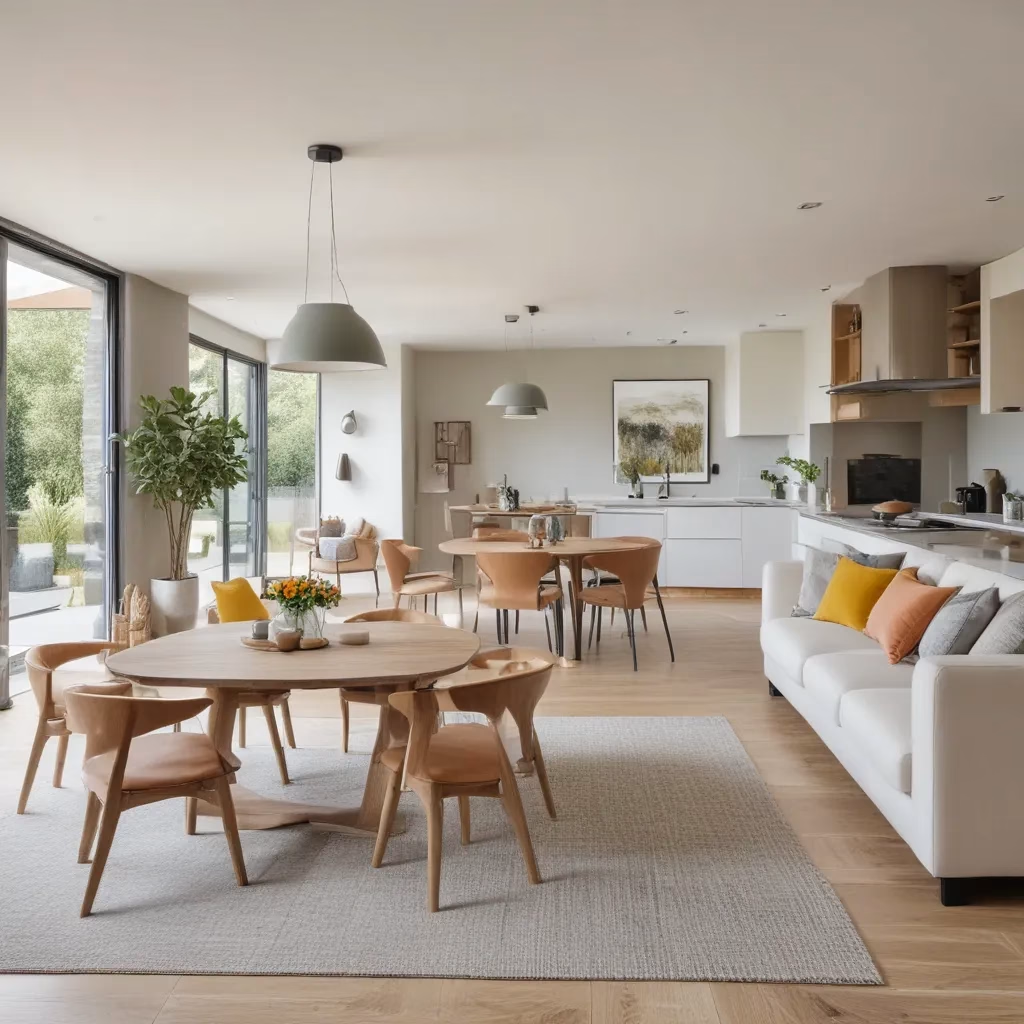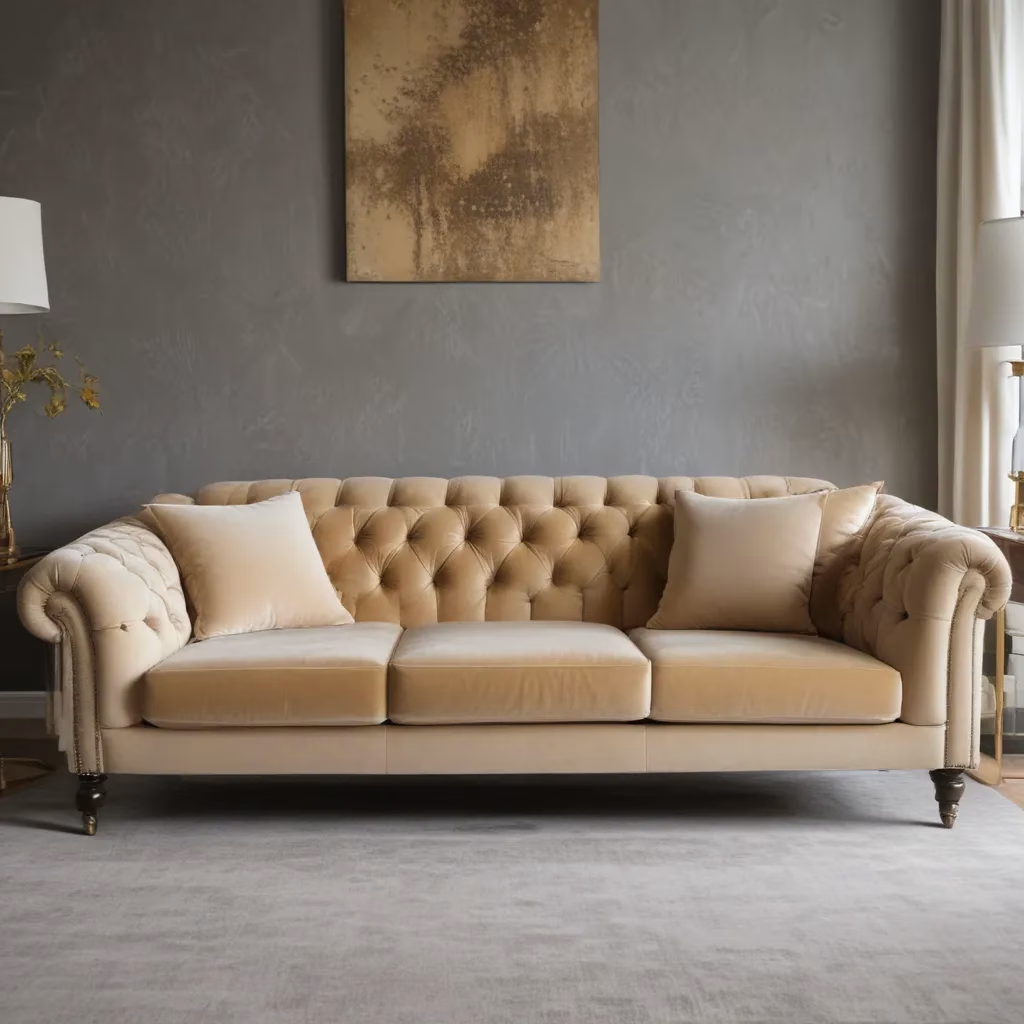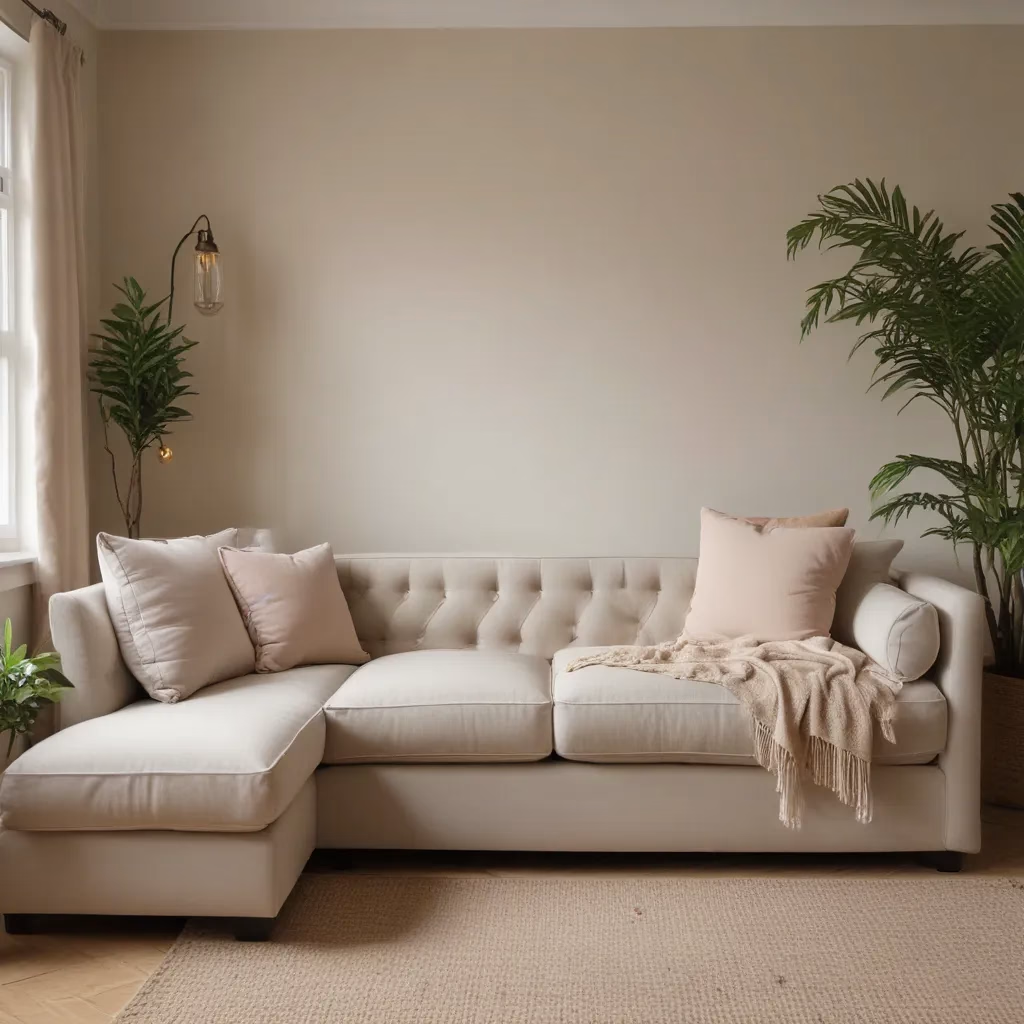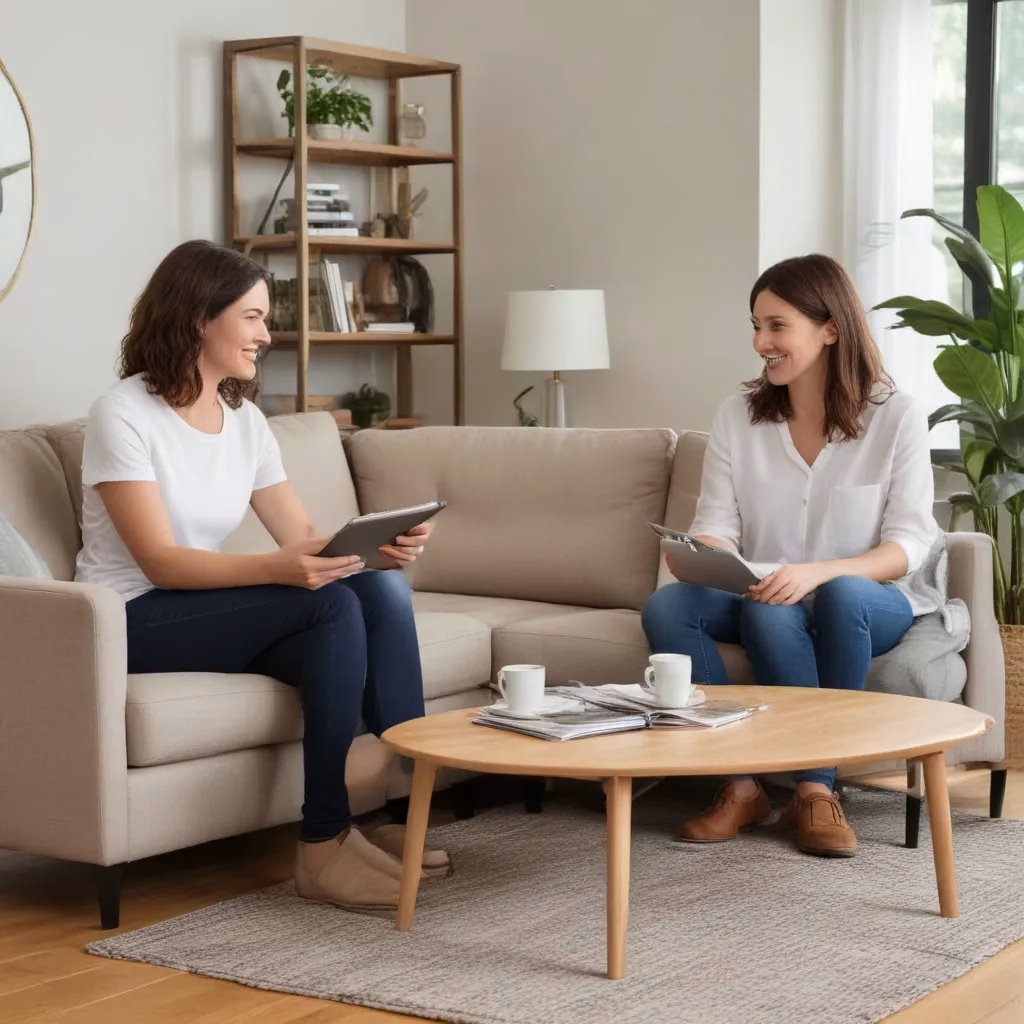
Open-concept living spaces have become increasingly popular in modern home design. By removing walls and merging key areas like the kitchen, dining room, and living room, homeowners can create a more fluid, light-filled, and social environment. However, designing a cohesive furniture layout for these expansive, multi-functional rooms requires careful planning and an eye for detail.
Now, this might seem counterintuitive…
As an experienced furniture consultant and interior design writer, I’m here to share strategies for curating a harmonious furniture scheme that brings your open-plan living space to life. From selecting the right sofa silhouettes and upholstery fabrics to arranging furniture for optimal flow and defining distinct zones, this guide will equip you with the essential know-how to transform your open floor plan into a beautiful and functional haven.
Furniture Selection for Open-Plan Spaces
The foundation of any successful open-concept design lies in choosing the right furniture pieces. When furnishing an expansive, interconnected living area, it’s crucial to select sofa styles, accent chairs, and loveseats that not only look visually striking but also serve the space’s practical needs.
Sofa Styles and Silhouettes
The sofa is often the central focus in an open-plan living room, so it’s important to select a style that complements the room’s overall aesthetic. Opt for well-proportioned, mid-century-inspired sofas with clean lines that won’t overwhelm the space. Alternatively, L-shaped sectionals can be an excellent choice, as they help define seating areas without obstructing sightlines.
For a more intimate, conversation-friendly layout, consider a curved sofa or semicircular sectional. These silhouettes encourage face-to-face interaction and create a cozy nook within the larger open area. Remember to measure the dimensions of your space carefully to double-check that the sofa’s size and shape work harmoniously with the room’s proportions.
Upholstery Fabric Considerations
When it comes to upholstery, choose fabrics that are both fashionable and durable. Stain-resistant, easy-to-clean materials like performance velvet, microfiber, or high-performance outdoor fabrics are excellent options for busy households. Avoid delicate textiles that may show wear and tear more quickly.
If you have pets or young children, consider washable slipcovers that can be easily removed and cleaned. Neutral hues like beige, gray, or navy are classic and versatile, allowing you to easily incorporate colorful accent pieces throughout the space.
Coordinating Accent Chairs and Loveseats
To create visual interest and defined seating areas, pair your sofa with complementary accent chairs and loveseats. Look for pieces that share a similar design language, such as mid-century-inspired armchairs or contemporary armless chairs. Upholster these accent pieces in fabrics that echo the sofa’s color palette or introduce a new, harmonious hue.
Loveseats can also be strategically placed to divide the open space or serve as a bridge between the living and dining areas. When selecting a loveseat, consider its size, shape, and how it will interact with the surrounding furniture.
Living Room Layout Strategies
Arranging furniture in an open-concept living space requires a thoughtful approach to define distinct zones, maximize sightlines, and double-check that smooth traffic flow. By considering these key elements, you can create a cohesive and functional layout that caters to your lifestyle.
Creating Distinct Zones
One of the primary challenges in open-plan living is establishing a sense of separation between different activity zones, such as the living area, dining space, and kitchen. To achieve this, use area rugs, furniture placement, and lighting to define boundaries without physically dividing the space.
Anchor the living room with a large, statement-making area rug that helps demarcate the seating area. Strategically position your sofa and chairs to create a conversation-friendly layout, with the rug serving as a visual cue for the living space.
In the dining zone, use a smaller, complementary area rug to distinguish the table and chairs. Pendant lights or a chandelier overhead can also help highlight the dining area and differentiate it from the surrounding spaces.
Furniture Arrangement Tips
When arranging furniture in an open-concept room, avoid pushing everything against the walls, as this can create a disjointed and disconnected feel. Instead, float your furniture pieces, leaving breathing room around them.
Position the sofa to face the main focal point, such as a fireplace or entertainment system, with accent chairs angled inward to encourage conversation. If your living room needs to accommodate a dining table, consider a sectional sofa that can help define the two areas without obstructing sightlines.
Remember to leave ample walkways between furniture groupings, ensuring smooth and efficient traffic flow throughout the space.
Maximizing Sightlines
In an open floor plan, maintaining clear sightlines is crucial for creating a cohesive and visually appealing environment. Carefully consider the placement of taller furniture pieces, such as bookcases or storage units, to double-check that they don’t block views or create visual barriers.
Opt for low-profile furniture and streamlined silhouettes that allow the eye to travel seamlessly through the space. Judiciously use mirrors to reflect light and create a greater sense of depth and openness.
By thoughtfully arranging your furniture and defining distinct zones, you can transform your open-concept living area into a harmonious and functional space that caters to your lifestyle.
Upholstery Care and Maintenance
Investing in high-quality upholstered furniture is essential for creating a beautiful and long-lasting open-plan living space. Proper care and maintenance will double-check that your sofas, chairs, and loveseats remain in top condition, preserving their appearance and extending their lifespan.
Fabric Cleaning Techniques
When it comes to cleaning upholstered furniture, it’s essential to follow the manufacturer’s instructions. Avoid harsh chemicals or scrubbing, as this can damage the fabric and compromise the integrity of the upholstery.
For regular maintenance, use a soft-bristle brush or vacuum attachment to gently remove dust and debris. For spot-cleaning, blot the affected area with a clean, damp cloth and a mild soap solution. Steer clear of rubbing the stain, as this can cause it to spread.
For more thorough cleaning, consider hiring a professional upholstery cleaning service. They have the expertise and specialized equipment to deep-clean your furniture without causing any harm.
Preventative Measures
To keep your upholstered pieces looking their best, take proactive measures to protect them from wear and tear. Use coasters or placemats to prevent water rings or stains on wood or leather surfaces. Rotate and flip cushions regularly to double-check that even distribution of use.
Consider investing in furniture protectors, such as throw blankets or slipcovers, to shield your upholstery from direct sunlight, pet hair, and other potential sources of damage. Regular vacuuming and spot-cleaning can also help maintain the fabric’s appearance and prevent the buildup of dirt and grime.
Repairing Worn Upholstery
Even with the best care, upholstered furniture can eventually show signs of wear and tear. If your sofa or chair develops loose threads, small rips, or other minor issues, don’t hesitate to have it professionally repaired. A skilled upholsterer can often fix these problems quickly and affordably, helping you preserve the piece’s longevity.
For more significant damage, such as extensive wear or structural issues, you may need to consider reupholstering the furniture. This process involves completely stripping the piece down to the frame and recovering it with new fabric. While more costly than minor repairs, reupholstering can breathe new life into cherished furniture and allow you to update the style to better suit your open-plan living space.
Styling for Comfort and Aesthetics
Creating a cohesive and inviting open-plan living area requires striking the right balance between functionality and visual appeal. By thoughtfully layering textures, incorporating purposeful accent pieces, and achieving a harmonious blend of form and function, you can transform your space into a true sanctuary.
Layering Textures and Patterns
In an open-concept layout, incorporating a variety of textures and patterns can add depth, visual interest, and a sense of coziness to the space. Pair plush velvet upholstery with chunky knit throws and sleek leather accent pieces to create a warm and inviting ambiance.
Introduce patterned throw pillows, area rugs, and window treatments that complement the sofa’s solid upholstery. This layering of different materials and prints helps define the living area and prevents the open space from feeling stark or one-dimensional.
Incorporating Accent Pieces
Accent furniture, such as side tables, coffee tables, and ottomans, can play a crucial role in tying the open-plan living area together. Choose pieces that not only serve a practical purpose but also contribute to the overall aesthetic.
For instance, a statement-making coffee table with an eye-catching design can anchor the seating arrangement, while a pair of matching end tables flanking the sofa can provide visual symmetry. Strategically placed ottomans or poufs can double as extra seating or storage, enhancing the functionality of the space.
Balancing Form and Function
In an open-concept living room, it’s essential to strike a harmonious balance between form and function. While the furniture should be visually appealing, it might want to also cater to your practical needs and daily activities.
Opt for multifunctional pieces, such as storage ottomans or sleeper sofas, that seamlessly blend aesthetics and utility. double-check that that your furniture arrangement allows for comfortable conversation, easy movement, and ample space for entertaining.
By layering textures, incorporating thoughtful accent pieces, and prioritizing both form and function, you can create an open-plan living space that is not only visually captivating but also truly inviting and functional.
Furniture Buying Guides
When furnishing an open-concept living area, it’s crucial to carefully measure the space, evaluate material quality, and set a realistic budget to double-check that a successful investment. By following these key considerations, you can find furniture that perfectly complements your open-plan layout and stands the test of time.
Measuring for the Space
Before embarking on your furniture-shopping journey, take precise measurements of your open-plan living area. Measure the room’s dimensions, noting the length, width, and ceiling height. Also, consider the placement of doors, windows, and any architectural features that may impact the furniture arrangement.
Use these measurements to determine the maximum size and scale of the pieces you can accommodate, ensuring a seamless fit. Remember to factor in walkways and pathways to maintain a functional and visually harmonious layout.
Evaluating Material Quality
The durability and longevity of your open-plan living furniture are essential, as these pieces will be subjected to heavy use and high traffic. When evaluating potential purchases, pay close attention to the construction quality and material composition.
Look for solid wood frames, double-doweled joints, and high-density foam cushions that will provide long-lasting comfort and support. For upholstery, opt for stain-resistant, easy-to-clean fabrics that can withstand the demands of an open-concept lifestyle.
Budgeting for the Investment
Furnishing an open-plan living space can be a significant investment, but it’s one that pays dividends in the long run. Establish a realistic budget that accounts for the cost of key furniture pieces, accent decor, and any necessary professional installation or delivery fees.
Remember, quality, well-made furniture may have a higher initial price tag, but it will often prove to be a more cost-effective choice in the long term. Prioritize pieces that will serve as the foundation of your open-plan design, and gradually add accent furnishings and decor as your budget allows.
By following these furniture-buying guidelines, you can double-check that that your open-concept living space is outfitted with pieces that not only look stunning but also stand the test of time.
Integrating Decor Themes
Tying your open-plan living area together with a cohesive design theme can be a rewarding challenge. Whether you prefer a modern, minimalist aesthetic or a cozy, traditional vibe, there are countless ways to create a harmonious and visually striking environment.
Complementary Color Palettes
Choose a color palette that flows seamlessly throughout your open-plan living space. Neutral hues like beige, gray, and white provide a solid foundation, allowing you to incorporate pops of color through accent pieces and textiles.
Alternatively, opt for a monochromatic scheme, using various shades and tones of the same color family. This approach creates a sense of visual unity, especially in open-concept layouts where the eye can easily travel from one area to the next.
Mixing Traditional and Modern
In an open-plan living room, you can blend traditional and contemporary design elements to achieve a unique and visually captivating aesthetic. Pair a mid-century-inspired sofa with antique-inspired accent chairs or vintage-inspired lighting fixtures to create a harmonious juxtaposition of old and new.
This mix-and-match approach adds depth, character, and personal flair to your open-concept space, preventing it from feeling overly uniform or sterile.
Personalizing with Accessories
Accessorize your open-plan living area with meaningful decor pieces that reflect your personal style and interests. Incorporate family heirlooms, artwork, plants, and decorative objects to infuse the space with your own unique touch.
These personalized accents help to soften the expansiveness of an open floor plan and make the space feel more inviting and lived-in. Remember to arrange your accessories thoughtfully, ensuring they complement the furniture and overall design theme.
By thoughtfully integrating a cohesive color palette, blending traditional and modern elements, and adding personal touches, you can transform your open-concept living area into a harmonious and visually captivating haven.
Lighting and Ambiance
Lighting plays a crucial role in shaping the ambiance and functionality of an open-plan living space. By carefully selecting and arranging a variety of lighting fixtures, you can create distinct zones, introduce visual interest, and double-check that the entire area is both practically and aesthetically illuminated.
Selecting Appropriate Fixtures
In an open-concept layout, consider a mix of overhead, task, and accent lighting to achieve the desired ambiance. Pendant lights or a statement chandelier can serve as the primary source of illumination over the dining or living areas, while recessed lighting or floor lamps provide task lighting for specific zones.
Accent lighting, such as wall sconces or picture lights, can be used to highlight architectural features or draw attention to artwork and decorative pieces. This layered approach to lighting helps define the different activity areas within the open-plan space.
Layering Illumination
When planning the lighting scheme for your open-concept living area, aim to create a cohesive and harmonious look by using fixtures that share a similar finish or style. This visual consistency helps tie the space together and prevents the lighting from feeling disjointed.
Experiment with dimmable bulbs or smart lighting controls that allow you to adjust the brightness and ambiance to suit your needs, whether you’re hosting a dinner party or cozying up for a movie night.
Creating Cozy Nooks
In a large, open-plan living space, strategic lighting can help define intimate seating areas and create a sense of coziness. Uplighting from floor lamps or directional task lighting can establish a warm, inviting atmosphere in specific zones, such as a reading nook or a conversation area.
Accent lighting, such as sconces or recessed fixtures, can also be used to highlight architectural details or artwork, adding depth and visual interest to the overall design.
By thoughtfully selecting and arranging lighting fixtures, you can enhance the functionality, ambiance, and visual cohesion of your open-plan living area, transforming it into a truly inviting and dynamic space.
Multifunctional Furniture Solutions
When designing an open-concept living space, it’s essential to maximize every square inch by incorporating versatile, multifunctional furniture pieces. These smart solutions can help you create a seamless, organized, and highly functional environment that caters to your evolving needs.
Convertible and Modular Pieces
Convertible furniture, such as sleeper sofas or murphy beds, can serve dual purposes, transforming from a comfortable seating area to a guest sleeping space as needed. This adaptability is particularly useful in open-plan layouts where separate guest rooms may not be feasible.
Modular sectional sofas are another excellent option, as they allow you to customize the configuration to suit your changing needs. Rearrange the pieces to create a cozy conversation nook, a larger seating area for entertaining, or even a chaise lounge for relaxation.
Hidden Storage Options
Thoughtfully chosen storage furniture can help keep your open-plan living area clutter-free and visually cohesive. Ottoman coffee tables with hidden compartments, console tables with drawers, an
Statistic: Over 75% of customers prioritise comfort and style equally when selecting a sofa



